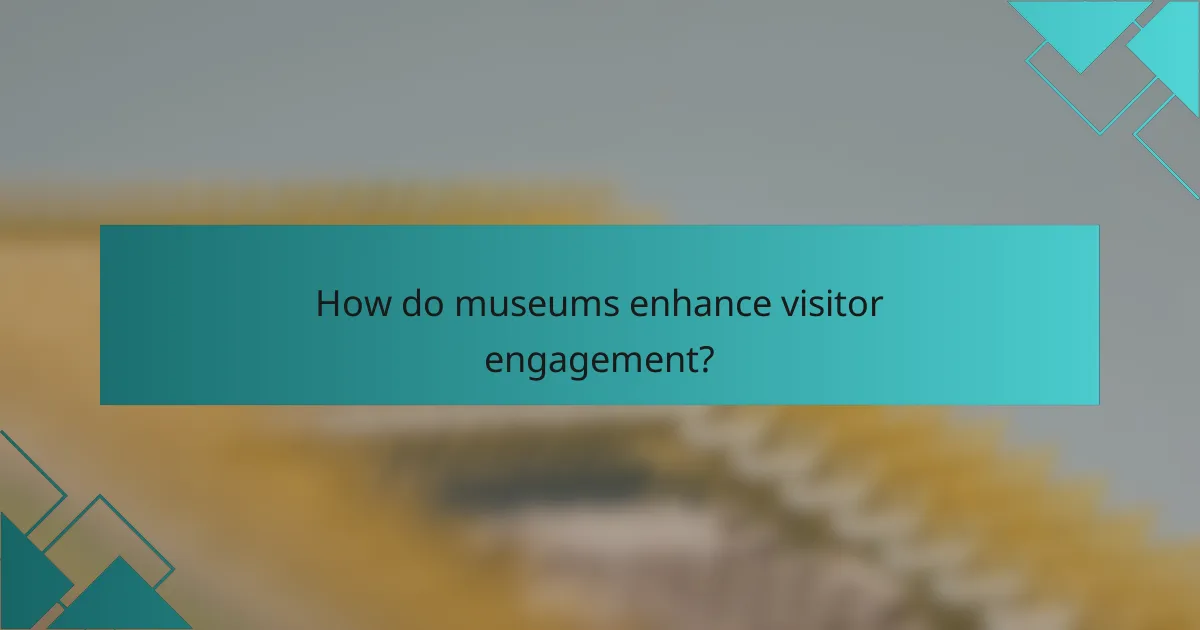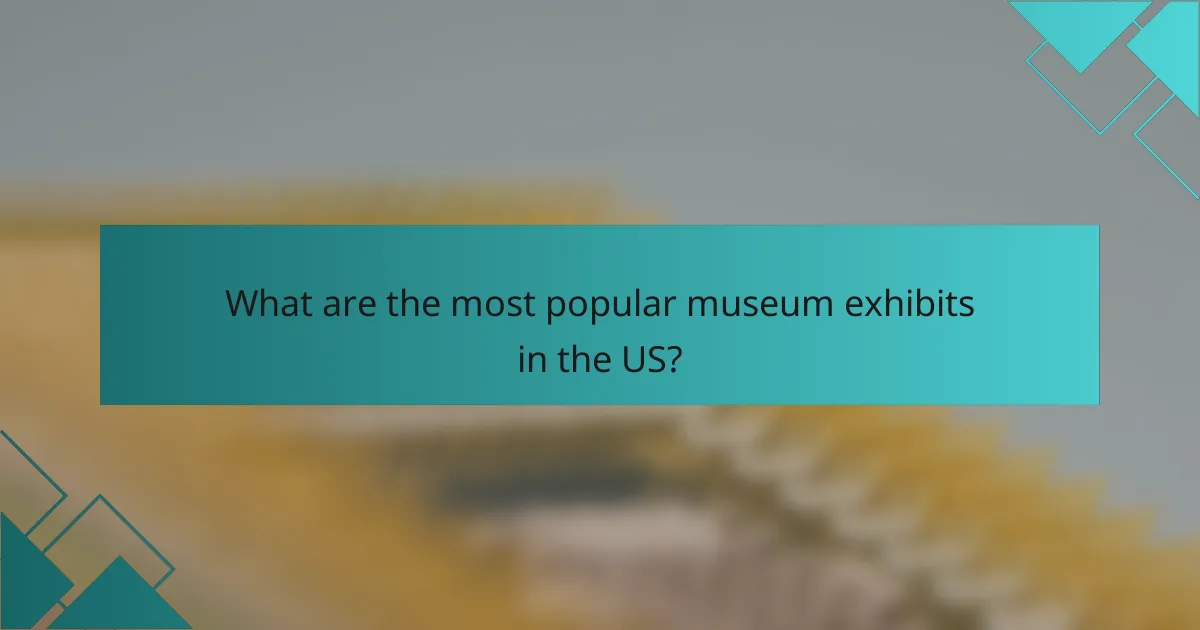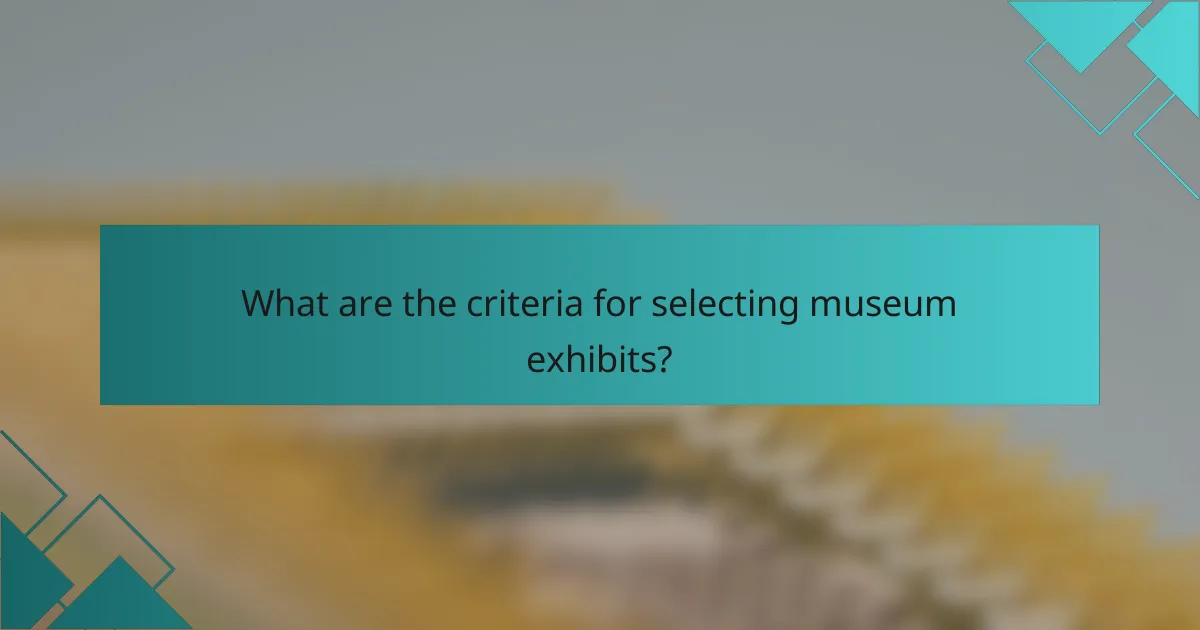Museums play a vital role in enhancing visitor engagement by offering immersive experiences that promote interaction and learning. With diverse exhibits showcasing art, history, and science, they attract millions of visitors annually, fostering a deeper connection to cultural and educational themes. Through careful curation and preservation of collections, museums ensure that artifacts are not only protected but also serve to educate and inspire future generations.

How do museums enhance visitor engagement?
Museums enhance visitor engagement by creating immersive experiences that encourage interaction and learning. Through various methods, they foster a deeper connection between visitors and the exhibits, making the experience more memorable and informative.
Interactive exhibits
Interactive exhibits allow visitors to engage directly with the displays, often through hands-on activities or technology. These experiences can include touch screens, augmented reality, or physical components that invite participation. For example, science museums often feature experiments that visitors can conduct themselves, enhancing understanding through active involvement.
When designing interactive exhibits, consider the target audience’s age and interests to ensure accessibility and relevance. Engaging elements should be intuitive and encourage exploration, making the learning process enjoyable.
Guided tours
Guided tours provide structured experiences led by knowledgeable staff or volunteers, offering insights that enhance understanding of the exhibits. These tours can vary in length and focus, catering to different interests, such as art history or scientific discoveries. Visitors often appreciate the opportunity to ask questions and receive personalized information.
To maximize engagement, consider offering tours at various times throughout the day and promoting them through social media or on-site signage. Tailoring tours to specific themes or demographics can also attract diverse audiences.
Workshops and events
Workshops and events encourage active participation and learning through hands-on experiences related to the museum’s theme. These can range from art classes to lectures and family-friendly activities. Such programs not only engage visitors but also foster community involvement and collaboration.
To effectively promote workshops, use local advertising channels and social media. Offering discounts for groups or families can also increase participation and create a more vibrant atmosphere within the museum.
Digital experiences
Digital experiences, such as virtual tours and mobile apps, expand visitor engagement beyond the physical museum space. These tools can provide additional context, multimedia content, and interactive features that enhance the learning experience. For instance, apps may include audio guides or augmented reality features that bring exhibits to life.
To ensure effectiveness, keep digital content user-friendly and regularly updated. Engaging visitors through social media platforms can also drive interest in these digital offerings.
Community outreach programs
Community outreach programs help museums connect with local populations, fostering inclusivity and accessibility. These initiatives can include school partnerships, free admission days, or traveling exhibits that bring museum resources to underserved areas. By engaging with the community, museums can build lasting relationships and encourage future visits.
To enhance outreach efforts, collaborate with local organizations and schools to identify community needs. Regular feedback from participants can help refine programs and ensure they remain relevant and impactful.

What are the most popular museum exhibits in the US?
The most popular museum exhibits in the US attract millions of visitors each year, showcasing a diverse range of art, history, and science. Notable museums often feature iconic collections that highlight cultural significance and educational value.
Smithsonian National Museum of Natural History
The Smithsonian National Museum of Natural History in Washington, D.C. is renowned for its vast collection of specimens and artifacts. Highlights include the Hope Diamond, dinosaur fossils, and an extensive array of taxidermy exhibits that illustrate biodiversity.
Visitors can explore interactive displays and educational programs that engage audiences of all ages. Admission is free, making it accessible for families and tourists alike.
Metropolitan Museum of Art
The Metropolitan Museum of Art, located in New York City, is one of the largest and most prestigious art museums in the world. Its collection spans over 5,000 years of art, featuring works from ancient Egypt to contemporary pieces.
Popular exhibits include European paintings, American decorative arts, and the Costume Institute’s annual fashion exhibition. Tickets are required, with suggested donations, allowing visitors to contribute as they see fit.
California Academy of Sciences
The California Academy of Sciences in San Francisco combines a natural history museum, aquarium, and planetarium under one roof. Its Living Roof and the Steinhart Aquarium are particularly popular, showcasing a variety of ecosystems and marine life.
Interactive exhibits, such as the earthquake simulator, provide hands-on learning experiences. Admission prices vary, with discounts available for children and families.
American Museum of Natural History
The American Museum of Natural History in New York City is famous for its impressive dinosaur skeletons and the Rose Center for Earth and Space. The museum’s dioramas and the Hall of Ocean Life are must-see attractions for visitors.
With a range of educational programs and special exhibitions, it caters to both casual visitors and serious scholars. Admission is based on a pay-what-you-wish model, making it accessible to a broad audience.

How do museums curate their collections?
Museums curate their collections through a systematic process that involves acquiring, conserving, and displaying artifacts. This ensures that the items are preserved for future generations while also providing educational and engaging experiences for visitors.
Acquisition processes
The acquisition process involves identifying and obtaining items that align with a museum’s mission and collection strategy. Museums often consider provenance, significance, and condition when evaluating potential acquisitions.
Common methods of acquisition include donations, purchases, and long-term loans from other institutions or private collectors. Museums may also participate in exchanges with other museums to diversify their collections.
Conservation techniques
Conservation techniques are essential for preserving artifacts and ensuring their longevity. These techniques can range from basic cleaning to complex restoration processes, depending on the material and condition of the item.
For example, paper artifacts may require specialized storage conditions to prevent deterioration, while textiles might need careful handling to avoid damage. Museums often employ trained conservators who follow established guidelines and best practices to maintain the integrity of their collections.
Exhibit design principles
Exhibit design principles focus on creating engaging and educational displays that enhance visitor experience. Key considerations include layout, lighting, and interpretive materials that help convey the story behind the artifacts.
Effective exhibit design often incorporates interactive elements, such as touchscreens or hands-on activities, to encourage visitor participation. Additionally, museums must consider accessibility to ensure that all visitors can enjoy and learn from the exhibits.

What role do technology and social media play in museums?
Technology and social media significantly enhance the way museums engage with visitors, making exhibits more accessible and interactive. By leveraging these tools, museums can reach broader audiences and create immersive experiences that extend beyond physical visits.
Virtual tours
Virtual tours allow museums to showcase their collections online, enabling visitors to explore exhibits from anywhere in the world. These tours often use 360-degree photography or video, providing an immersive experience that can attract remote audiences.
To implement effective virtual tours, museums should ensure high-quality visuals and user-friendly navigation. Offering guided tours with expert commentary can further enhance the experience, making it more engaging and informative.
Social media marketing
Social media marketing is crucial for museums to connect with potential visitors and share updates about exhibits and events. Platforms like Instagram, Facebook, and Twitter allow museums to showcase their collections through engaging visuals and stories, creating a sense of community.
To maximize impact, museums should post regularly and interact with followers. Utilizing targeted ads can also help reach specific demographics, increasing visitor numbers and engagement.
Mobile apps for visitor engagement
Mobile apps enhance visitor engagement by providing interactive features such as audio guides, augmented reality experiences, and event notifications. These apps can enrich the museum experience, allowing visitors to access information at their fingertips.
When developing a mobile app, museums should focus on user experience and ensure it is easy to navigate. Incorporating features like personalized itineraries and feedback options can further improve visitor satisfaction and encourage repeat visits.

What are the criteria for selecting museum exhibits?
Selecting museum exhibits involves several key criteria that ensure the displays resonate with visitors and fulfill the institution’s mission. These criteria typically include relevance to the audience, historical significance, and educational value.
Relevance to audience
The relevance of an exhibit to its audience is crucial for engaging visitors. Museums often conduct surveys or focus groups to understand the interests and preferences of their target demographics. For example, a museum in a coastal city might prioritize marine life exhibits to attract local families and tourists.
Additionally, considering current events and cultural trends can enhance relevance. Exhibits that connect to contemporary issues, such as climate change or social justice, can draw in visitors who are eager to explore these topics in a historical context.
Historical significance
Historical significance refers to the importance of an exhibit in relation to past events, figures, or movements. Curators assess whether an item or collection provides insight into significant moments in history or represents pivotal cultural shifts. For instance, artifacts from a major war can illustrate the impact of that conflict on society.
Moreover, items that tell underrepresented stories or highlight diverse perspectives can enrich the historical narrative. Museums may prioritize these exhibits to ensure a more inclusive representation of history.
Educational value
Educational value is a key criterion for selecting museum exhibits, as it determines how well an exhibit can inform and enlighten visitors. Curators aim to create experiences that not only entertain but also educate, often incorporating interactive elements or guided tours to enhance learning.
Exhibits that align with educational standards or curriculum can attract school groups and families. For example, a science museum might feature hands-on exhibits that align with national science education standards, making them valuable resources for teachers and students alike.
